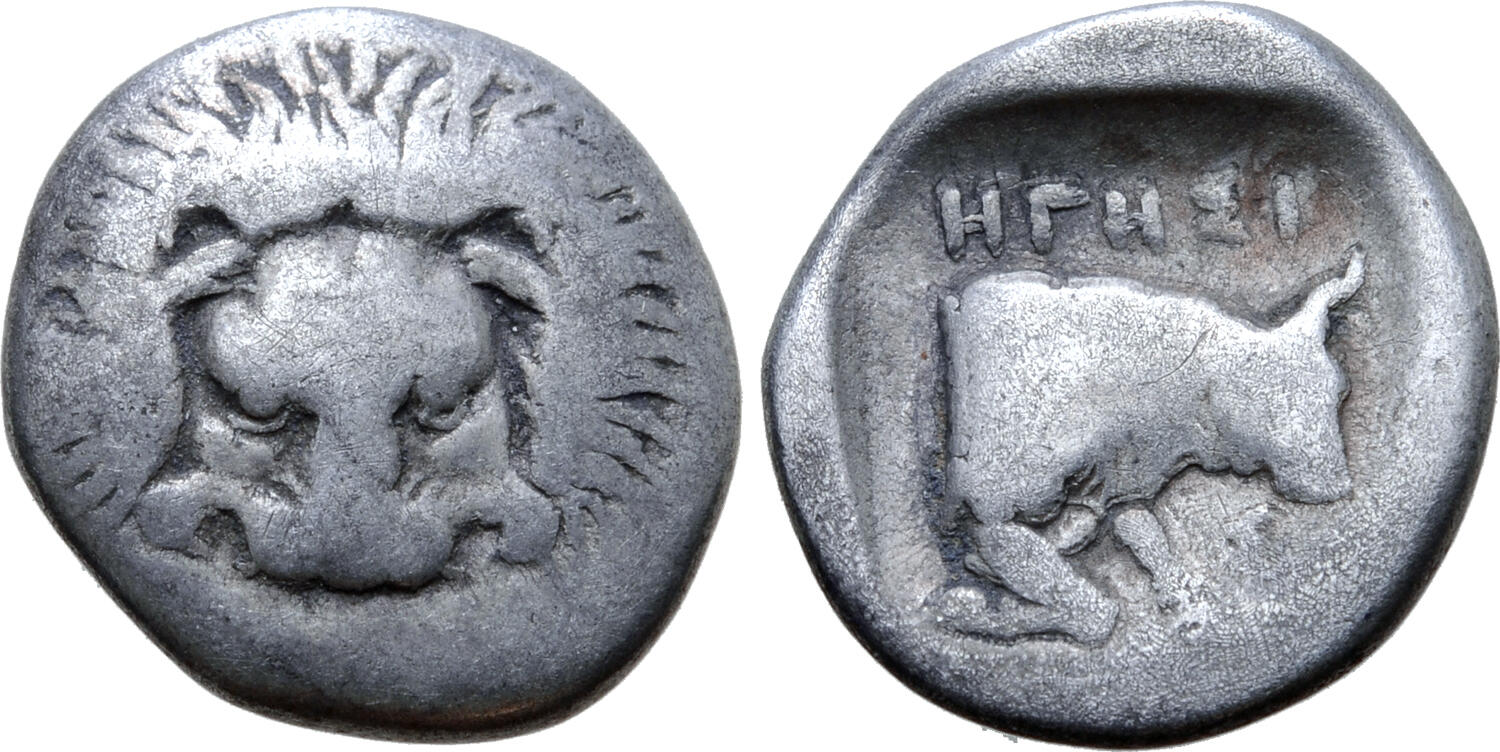AC 231b - Samos, silver, hemidrachm, 400-365 BC
From SILVER
Bilgischer (talk | contribs) |
|||
| Line 1: | Line 1: | ||
{{Die Study | {{Die Study | ||
| + | |Image=AC231b Samos.jpeg | ||
| + | |Image reference=https://www.acsearch.info/search.html?id=7492290 | ||
| + | |Obverse description=Lion's scalp facing. | ||
| + | |Reverse legend=HΓHΣI / Σ[Α] | ||
| + | |Reverse legend language=Greek | ||
| + | |Reverse description=Forepart of bull to right; HΓHΣI above, Σ[Α] in lower right field. | ||
|Mint=Samos | |Mint=Samos | ||
|Ancient region=Ionia (islands) | |Ancient region=Ionia (islands) | ||
| Line 10: | Line 16: | ||
|RQEM reference=RQMAC | |RQEM reference=RQMAC | ||
|RQEM reference number=231b | |RQEM reference number=231b | ||
| − | |Die study reference= | + | |Die study reference=Barron 1966 |
| − | |Coin series reference= | + | |Coin series reference=HGC 6, n° 1222 ; Sear II, n° 4647; RQEMAC, n° 231b |
| + | |Coin series web reference=https://greekcoinage.org/iris/id/samos_barron_1966_class_x_hemidrachms | ||
|Number of obverse dies=5 | |Number of obverse dies=5 | ||
|Number of reverse dies=7 | |Number of reverse dies=7 | ||
|Number of coins=12 | |Number of coins=12 | ||
}} | }} | ||
Latest revision as of 15:40, 6 May 2023
400 BCE - 365 BCE Silver 228 kg
Description
| ObverseInscription or printing placed on the obverse.: | Lion's scalp facing. |
| ReverseInscription or printing placed on the reverse.: | HΓHΣI / Σ[Α] (Greek).Forepart of bull to right, HΓHΣI above, Σ[Α] in lower right field. |
Mint and issuing power
| MintIdentifies the place of manufacture or issue of a numismatic object.: | Samos | Ancient regionAncient region.: | Ionia (islands) | Modern countryModern country: Turkey | AuthorityIdentifies the issuing power. The authority can be "pretended" when the name or the portrait of X is on the coin but he/she was not the issuing power. It can also be "uncertain" when there is no mention of X on the coin but he/she was the issuing power according to the historical sources: |
Chronology
| FromIdentifies the initial date in a range assigned in a numismatic context. | 400 BCE | toIdentifies the final date in a range assigned in a numismatic context.. | 365 BCE | PeriodTime period of the numismatic object.: Classical 480-323 BC |
Physical description
| MetalThe physical material (usually metal) from which an object is made.: | Silver |
Median weightMedian of the weights of numismatic objects (in grams). in grams | 1.60 | DenominationTerm indicating the value of a numismatic object. Examples: tetradrachm, chalkous, denarius.: | hemidrachm |
StandardStandard.: |
Image

AC231b Samos.jpeg [1]
References
| Die study referencePublication of the study: | Barron 19661Barron 1966 | ||
| Coin series referenceReference to coin series study: | HGC 62HGC 6, n° 1222, Sear II3Sear II, n° 4647, RQEMAC4RQEMAC, n° 231b | ||
| Coin series web referenceCoin series web references: | |||
Obverse dies distribution
no distribution is available
Reverse dies distribution
no distribution is available
Quantification
| Number of obversesNumber of obverse dies. ᵖ (o) | 5 | Number of singletons (o1)The number of singleton coins. ᵖ | |
| Number of reverse diesNumber of reverse dies. (r) | 7 | Number of coinsNumber of coins. (n) | 12 |
| Coins per obverse dieNumber of coins per obverse die. (n/o) | 2.4 | Coins per reverse dieNumber of coins per reverse die. (n/r) | 1.71 |
| Reverse per obverse ratioRatio of obverse dies divided by reverse dies. (r/o) | 1.4 | Percentage of singletons (o1)number of coins (n) divided by the number of singletons (o1) ᵖ | % |
| Original number of dies (O) (Carter 1983 formula)The estimation of the number of coins according to Carter 1983 ᵖ | 7.14 | Coins struck if 20,000 as average productivity per dieCoins made if the average productivity for obverses (according to Carter) is 20,000. ᵖ | 142,800 |
| Original number of dies (O) (Esty 2011 formula)The estimation of the number of coins according to the singleton formula in Esty 2011 ᵖ (O) | 8.57 | Survival rate if 20,000 as average productivity per dieSurvival rate if average productivity is 20,000. ᵖ | 0.00008 |
| Coverage (o = % of O) (Esty 1984 formula)Esty 1984 - coverage (% of O) ᵖ (o = % of O) | % | Die productivity if survival rate 1/2,000Average productivity if survival rate is 1/2,000. ᵖ | 3,361.34 |
| Weight of silver (in kg) if 20,000 coins per die (O = Carter formula)Carter 1983 * Median weight * 20000 (*10 if gold or electrum) ᵖ | 228 kg <br /> 228 kg | Die productivity if survival rate 1/5,000Average productivity if survival rate is 1/5,000. ᵖ | 8,403.36 |
Remarks
References
- ^ Barron, John Penrose (1966), The Silver Coins of Samos, London, xii, 244 p., 32 pl.
- ^ Hoover, Oliver D. (2010), The Handbook of Greek Coinage Series, volume 6 : handbook of coins of the islands: Adriatic, Iionian, Thracian, Aegean, and Carpathian seas (excluding Crete and Cyprus), sixth to first centuries BC, Lancaster, 358 p.
- ^ Sear, David R. (1979), Greek coins and their values. Vol. II, Asia and North Africa, London, xlviii, p. 317-762
- ^ Callataÿ, François de (2003), Recueil quantitatif des émissions monétaires archaïques et classiques, Numismatique Romaine, Wetteren, VII + 267 p.